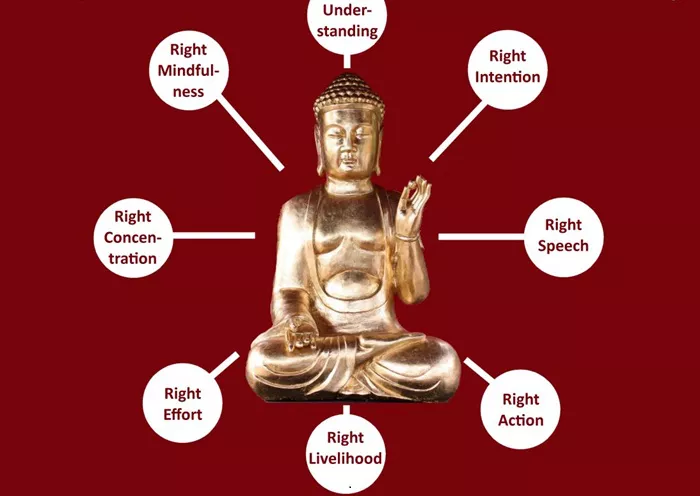The Noble Eightfold Path is a central teaching in Buddhism. It offers a practical guide to end suffering and achieve enlightenment. This path is part of the Fourth Noble Truth, which explains how to overcome life’s challenges. The Eightfold Path is divided into three main categories: Wisdom, Ethical Conduct, and Mental Discipline. Each category contains specific practices that support spiritual growth.
Understanding the Noble Eightfold Path
The Eightfold Path consists of eight interconnected practices. These practices are not steps to be followed in order but are aspects of a holistic approach to life. They are:
- Right Understanding
- Right Intention
- Right Speech
- Right Action
- Right Livelihood
- Right Effort
- Right Mindfulness
- Right Concentration
Each of these elements plays a role in reducing suffering and promoting a balanced, ethical, and mindful life.
1. Right Understanding
Right Understanding means seeing things as they truly are. It involves understanding the Four Noble Truths:
- Life involves suffering (dukkha).
- Suffering is caused by craving and attachment.
- Suffering can end by eliminating craving.
- The path to the end of suffering is the Noble Eightfold Path.
By grasping these truths, one gains insight into the nature of existence and the causes of suffering.
2. Right Intention
Right Intention involves cultivating thoughts of renunciation, goodwill, and harmlessness. It means letting go of desires, ill-will, and cruelty. This practice helps to align one’s mind with ethical and compassionate goals.
3. Right Speech
Right Speech encourages speaking truthfully and kindly. It involves avoiding:
- Lying
- Divisive speech
- Harsh words
- Idle chatter
By practicing Right Speech, one fosters harmony and trust in relationships.
4. Right Action
Right Action involves behaving peacefully and harmoniously. It includes refraining from:
- Harming living beings
- Stealing
- Sexual misconduct
Engaging in Right Action leads to a life of integrity and respect for others.
5. Right Livelihood
Right Livelihood means earning a living in a way that does not harm others. It involves avoiding professions that:
- Involve killing
- Exploit others
- Deceive people
Choosing Right Livelihood supports ethical conduct and social responsibility.
6. Right Effort
Right Effort is the mental energy directed towards the elimination of unwholesome states and the cultivation of wholesome ones. It involves:
- Preventing negative states from arising
- Overcoming existing negative states
- Developing positive states
- Maintaining positive states
Through Right Effort, one develops a disciplined and focused mind.
7. Right Mindfulness
Right Mindfulness is the practice of being aware of the body, feelings, mind, and phenomena. It involves observing these aspects without attachment or aversion. This practice enhances clarity and insight into the nature of reality.
8. Right Concentration
Right Concentration refers to developing deep states of mental focus. It is achieved through practices like meditation, leading to a calm and unified mind. This concentration supports the development of wisdom and insight.
The Three Divisions of the Path
The Noble Eightfold Path is often categorized into three divisions, each focusing on a different aspect of spiritual development:
1. Wisdom (Prajna)
Wisdom involves understanding the true nature of reality. It is cultivated through:
- Right Understanding
- Right Intention
These practices help to develop insight and clarity.
2. Ethical Conduct (Sila)
Ethical Conduct is the practice of moral behavior. It is developed through:
- Right Speech
- Right Action
- Right Livelihood
These practices promote harmony and respect in relationships.
3. Mental Discipline (Samadhi)
Mental Discipline involves training the mind to be focused and clear. It is cultivated through:
- Right Effort
- Right Mindfulness
- Right Concentration
These practices lead to a calm and concentrated mind.
Applying the Noble Eightfold Path in Daily Life
Implementing the Noble Eightfold Path in daily life involves integrating its principles into everyday actions and decisions. Here are some practical ways to apply each aspect:
- Right Understanding: Study Buddhist teachings and reflect on the nature of suffering and its causes.
- Right Intention: Cultivate thoughts of compassion and non-harm towards all beings.
- Right Speech: Practice speaking truthfully and kindly, avoiding gossip and harsh words.
- Right Action: Engage in activities that promote peace and well-being, avoiding harmful behaviors.
- Right Livelihood: Choose a profession that aligns with ethical principles and does not cause harm.
- Right Effort: Work on eliminating negative thoughts and developing positive mental states.
- Right Mindfulness: Be aware of your thoughts, feelings, and actions in the present moment.
- Right Concentration: Practice meditation to develop a focused and calm mind.
By incorporating these practices into daily life, one can move closer to the goal of enlightenment.
The Symbol of the Eightfold Path
The Eightfold Path is often represented by the Dharma Wheel, also known as the Dharmachakra. This symbol illustrates the eight spokes of the wheel, each representing one aspect of the path. The wheel signifies the Buddha’s teachings and the path to liberation.
Conclusion
The Noble Eightfold Path is a comprehensive guide to living a life that reduces suffering and leads to enlightenment. By practicing Right Understanding, Right Intention, Right Speech, Right Action, Right Livelihood, Right Effort, Right Mindfulness, and Right Concentration, individuals can cultivate wisdom, ethical conduct, and mental discipline. These practices are interrelated and support each other, forming a holistic approach to spiritual development.
Embracing the Eightfold Path is not about following a set of rules but about transforming one’s mind and actions to align with the principles of Buddhism. It offers a practical framework for living a life of compassion, clarity, and peace.

